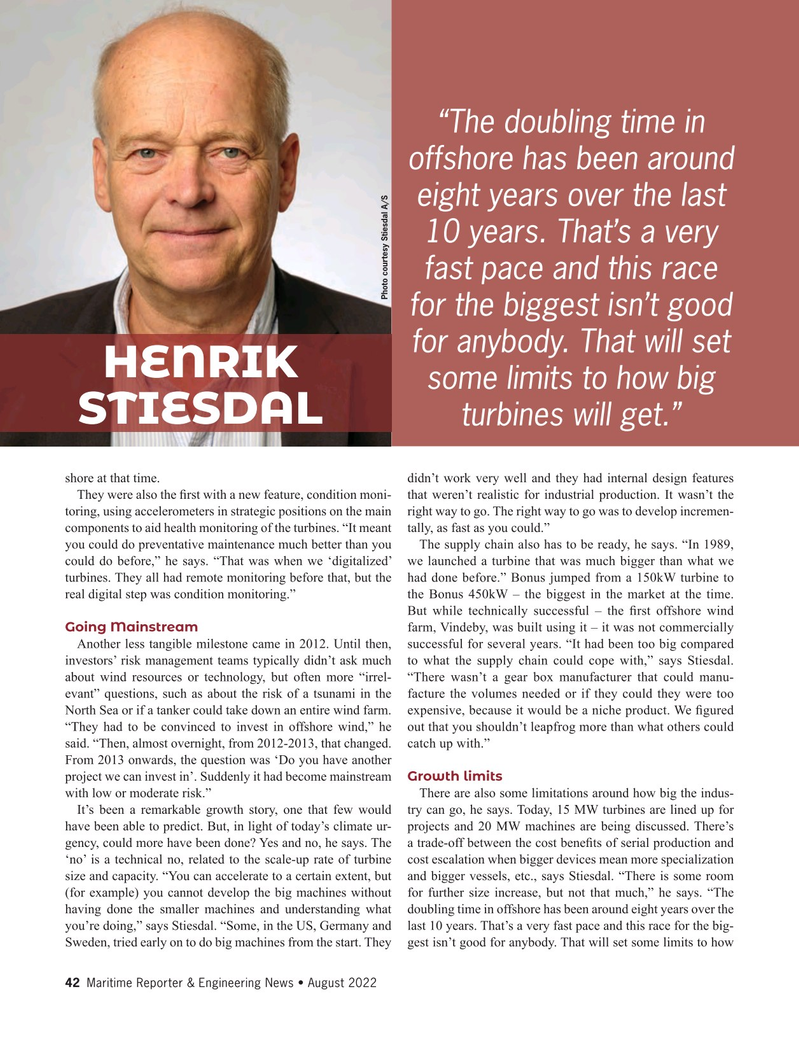
Page 42: of Maritime Reporter Magazine (August 2022)
The Shipyard Annual
Read this page in Pdf, Flash or Html5 edition of August 2022 Maritime Reporter Magazine
“The doubling time in offshore has been around eight years over the last 10 years. That’s a very fast pace and this race
Photo courtesy Stiesdal A/S for the biggest isn’t good for anybody. That will set
HENRIK some limits to how big
STIESDAL turbines will get.” shore at that time. didn’t work very well and they had internal design features
They were also the ? rst with a new feature, condition moni- that weren’t realistic for industrial production. It wasn’t the toring, using accelerometers in strategic positions on the main right way to go. The right way to go was to develop incremen- components to aid health monitoring of the turbines. “It meant tally, as fast as you could.” you could do preventative maintenance much better than you The supply chain also has to be ready, he says. “In 1989, could do before,” he says. “That was when we ‘digitalized’ we launched a turbine that was much bigger than what we turbines. They all had remote monitoring before that, but the had done before.” Bonus jumped from a 150kW turbine to real digital step was condition monitoring.” the Bonus 450kW – the biggest in the market at the time.
But while technically successful – the ? rst offshore wind
Going Mainstream farm, Vindeby, was built using it – it was not commercially
Another less tangible milestone came in 2012. Until then, successful for several years. “It had been too big compared investors’ risk management teams typically didn’t ask much to what the supply chain could cope with,” says Stiesdal. about wind resources or technology, but often more “irrel- “There wasn’t a gear box manufacturer that could manu- evant” questions, such as about the risk of a tsunami in the facture the volumes needed or if they could they were too
North Sea or if a tanker could take down an entire wind farm. expensive, because it would be a niche product. We ? gured “They had to be convinced to invest in offshore wind,” he out that you shouldn’t leapfrog more than what others could said. “Then, almost overnight, from 2012-2013, that changed. catch up with.”
From 2013 onwards, the question was ‘Do you have another project we can invest in’. Suddenly it had become mainstream Growth limits with low or moderate risk.” There are also some limitations around how big the indus-
It’s been a remarkable growth story, one that few would try can go, he says. Today, 15 MW turbines are lined up for have been able to predict. But, in light of today’s climate ur- projects and 20 MW machines are being discussed. There’s gency, could more have been done? Yes and no, he says. The a trade-off between the cost bene? ts of serial production and ‘no’ is a technical no, related to the scale-up rate of turbine cost escalation when bigger devices mean more specialization size and capacity. “You can accelerate to a certain extent, but and bigger vessels, etc., says Stiesdal. “There is some room (for example) you cannot develop the big machines without for further size increase, but not that much,” he says. “The having done the smaller machines and understanding what doubling time in offshore has been around eight years over the you’re doing,” says Stiesdal. “Some, in the US, Germany and last 10 years. That’s a very fast pace and this race for the big-
Sweden, tried early on to do big machines from the start. They gest isn’t good for anybody. That will set some limits to how 42 Maritime Reporter & Engineering News • August 2022
MR #8 (34-49).indd 42 8/1/2022 2:51:04 PM

 41
41

 43
43
